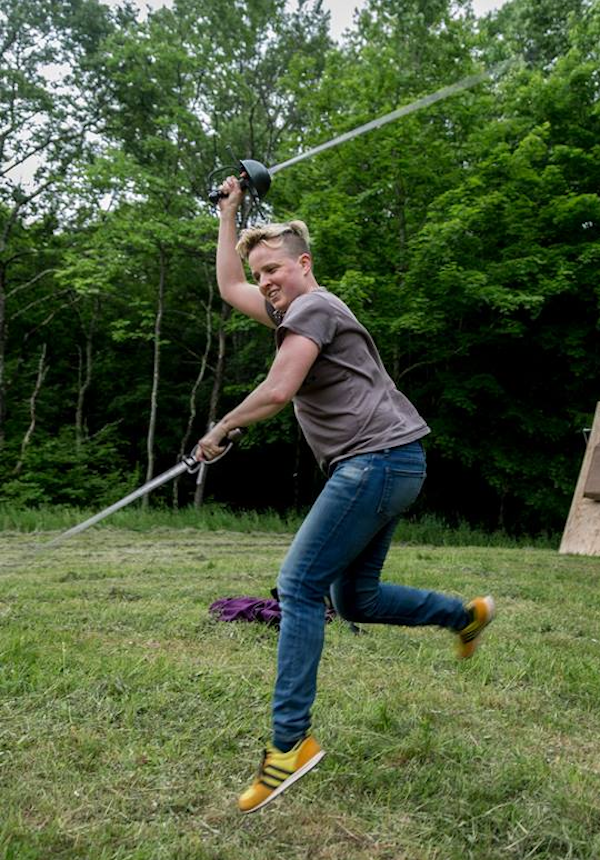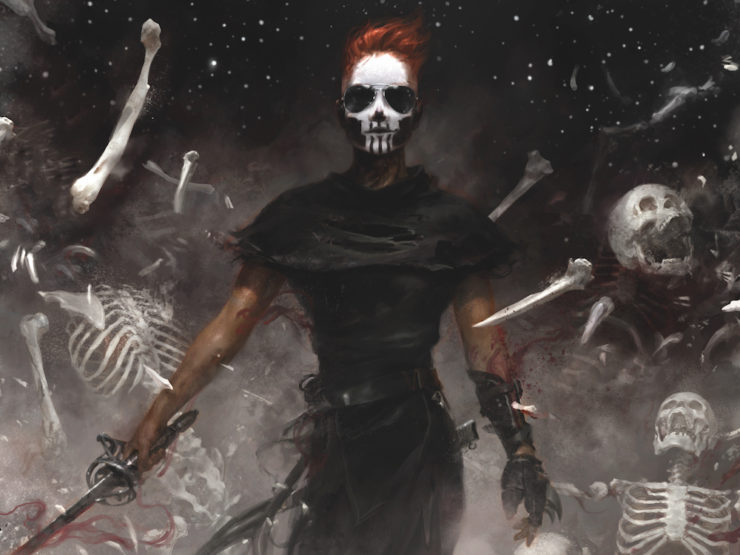“You want to fight it.”
“Yep.”
“Because it looked…a little like swords.”
“Yop.”
The other day, a friend texted me a screenshot of this choice snippet of dialogue from Gideon the Ninth, accompanied by just two words: “It you.” (Busted.)
I did not write that bit, I fired back, grinning uncontrollably. But she’s got my number. I never met a swordy-looking thing I didn’t want to fight, which is probably why Gideon author Tamsyn Muir hired me.
I’ve been a writer a distressingly long time. I’ve had a lot of bylines. I ran a news outlet for awhile. But I’ve been straying further and further from the paddock of journalism lately. It’s a rough age for facts, and the darker this timeline gets, the brighter more speculative worlds shine. At the moment, the work I’m proudest of is helping Tamsyn choreograph the swordfighting in Gideon the Ninth.
I’m so unspeakably chuffed at having been allowed to lay my grubby hands on this book. It’s just—it’s so much. It’s so good. Where has it been all my life? How dare it come to me now? As a Teen Lesbian with a raging SFF problem once upon a time, in the bad old 90s, I did not have any hot butch sword-wielding dumpster fire literary heroes to speak of. Frankly, there should be more of them now, but seeing as the preposterously extra Gideon Nav is the equivalent of at least half a dozen regular ones all Voltronned together, I’ll have to be content.
My qualifications for being a sword book wrangler, such as they are, are these: writing chops, five or six years of off-and-on training (and occasional competition) with longsword, somewhat more than that in sport fencing with foil, a mighty if amateurish lust for rapier-shaped objects, and a vast reserve of personal belligerence. It’s not a bad résumé, if you’re looking to get a sense for how words and weapons play together. Training with the longsword is one of the most mentally, physically, and, yea, emotionally challenging things you can do with your body. Sport fencing, though sometimes derided by more martial sword practitioners, is a deep apprenticeship in the alchemy of movement and time—and a valuable teacher of the practical uses of aggression, especially for the female-socialized.
Most of the martial weapons training I’ve done is in the use of the two-handed German longsword, through the world of Historical European Martial Arts (HEMA). As a discipline, HEMA is both ancient and perversely young. The techniques of swordplay in HEMA are derived from manuscripts written by sword masters centuries ago, but the martial traditions they are grounded in died out long ago, rendered obsolete by more effective weapons of war and personal defense. Modern HEMA’s efforts to revive the various corpses of historical swordfighting technique are no more than a few decades old, and there is still plenty of active debate in the community about what various techniques are supposed to look like, or what the best rules for competition should be to encourage the development of better swordfighting skills.

Credit where credit is due: There are many people in HEMA with far deeper experience than I have in the technical and historical aspects of swordplay. I have had the great privilege of having my ass kicked, my fingers broken, and my head concussed by some of them. HEMA is also full of much more advanced Sixth House types who will kill you very brutally, not with swords, but with extensive nitpicking over the interpretation of a particular gloss in a sixteenth-century fencing manual they’ve been fondling for a decade. I offered to point Tamsyn toward some of them, but, shockingly, she declined.
I will not lie. Saying yes to this gig was nerve-wracking. I feared my role here, if I weren’t careful, would be to barge into the tenderest, rawest ventricle of Tamsyn’s heart, breathing heavily from the mouth, and set about bashing things in full tone-deaf Nerding Out About My Special Interest mode. Laying waste to a perfectly good novel with a bunch of sword blather about true and false edges, or why Zwerchhau breaks Vom Tag, or how the Baby Liechtenauer Jesus would be sad about the usage of the word “pommel” on page 1621, would just have been a demoralizing experience for everyone.
On the contrary: Swordreading proved delightful. I expect Tamsyn knew enough about me, and how I handle both swords and words, to have a reasonable idea of what sort of advice she’d be getting when she asked me to have a look at Gideon. The links that now bind us were forged in the crucible of fanfiction, which is a thing I suppose I can admit now that it’s the year of our Lord 2019, and every piece of culture that isn’t physically on fire is being run by Shameless Ascendant Nerds. I’ll say this much: Describing the choreography of bodies in motion in a way that’s clear, compelling, and compliant with the laws of physics is a real challenge, and one that fanfic (cough) does tend to prepare you for. A few years in the salt mines of Ao3 would do any writer good in the action-scenes department.
Tamsyn and I went back and forth on everything from guard posture to the balletics of combat, and I’m sure we sacrificed some measure of historical accuracy to the sterner master of Cracking Good Action. But the place I see my handiwork clearest in the book is in the knuckle-knife: the offhand weapon Gideon wields alongside her cavalier’s rapier. The knuckles were Tamsyn’s invention, and they were undeniably badass, but in early drafts, neither of us were quite sure how they worked. Are they defensive or offensive? Does she parry with them, like a historical rapierist with a dagger?
Pondering that question sent me down a rabbit hole of blade mechanics—and cranky feelings about protective gear, which any swordsperson who’s spent time in competition has a few of. Knives protruding from the back of a glove felt like a crude, unwieldy tool for engaging a foe’s blade—and there would have to be a hefty tang running down the back of the wielder’s arm to keep them stable under pressure. Parry wrong with them, and the knuckle-knife wielder would risk directing her opponent’s blade straight into the backs of her own fingers, with unhappy results. In the end, we decided that the knuckle-knife was offense: a crude weapon, a brawler’s weapon, an offhand used as a last resort not against an opponent’s blade, but more likely his face. The decision felt in-character for Gideon: a fiendishly talented fighter who is forced to use new and unfamiliar tools, and has to sacrifice some measure of subtlety in favor of crude effectiveness. The snippy reaction of the other cavaliers to Gideon’s choice of offhand weapon absolutely gave me life: “I simply can’t remember ever thinking knuckle-knives were a viable option,” Naberius sneers, upon seeing them.
Buy the Book


Gideon the Ninth
One of the most delightful aspects of this book, for me personally, was the fact that Gideon, who has trained in the two-handed longsword til it has become basically an extension of her body, has to switch disciplines abruptly and re-learn everything she knows about fight mechanics for a one-handed sword. It’s a daunting task. When wielding a two-handed sword, you can lead with either foot depending on how you intend to attack, and you can make lethal cuts from any direction. By contrast, rapier is much more two-dimensional: The weapon is as deadly as a longsword in the thrust, but no more than a minor harassment with a cut, so both bladework and footwork tend to be more linear. Switching from one to the other is not just a matter of moving your blade differently; the choice of weapon affects every aspect of how a fighter moves.
Gideon’s sword journey was a perfect opposite of mine. I came to longsword out of sport fencing, and there was and remains some deep discombobulation. Some of that one-handed weapon background was valuable. A sport fencer gets constant, relentless practice at distance and timing in a way that’s difficult to replicate with more dangerous weapons. But foil also left me with a lot of deeply unhelpful habits: Playing sword tag for years will not help you learn to wield a blade in a martial manner. Transitioning to a two-handed weapon has been, and still is, a process of grueling, repetitive re-learning.
For a weapons practitioner, getting to witness this kind of process porn close up is just juicy as hell. This must be how Ball Team people feel watching Sports Movies. Tamsyn handled it beautifully, spurred on by me chortling with joy every time Gideon made a face at her rapier. The awkwardness, the uphill battle of fighting one’s own muscle memory, and especially the trash talk about allegedly inferior weapons in this book are all too real.
A thing I have tried to keep foremost in mind for sword-writing—both in Gideon and my own fiction—is that a blade, even a great bloody big one, is a creature of subtlety. Thank the physics of leverage for that. A few inches of variance in the position of one sword against another in a bind can shift the balance of power entirely in a fight. The distinction between a real threat and a calculated feint can be tiny: a slight difference in distance or angle, a small tell in the way a sword-wielder moves. The point of a rapier, where all its lethal power lies, is controlled not by sweeping arm movements, but by the most precise action of the fingers. In HEMA, we talk a lot about the ‘buffel’—the large but artless bruiser that a learned swordsperson can defeat with skill—and mainly I sought to keep Gideon from coming off as one by making plaintive comments in Tamsyn’s Google docs like, ‘it’s not a mace, it’s more of a lever.’ Mission accomplished, I hope.
Also well worth keeping in mind when writing swordplay is that swords are dangerous. In another recent Tor.com essay arguing this seemingly obvious point, writer and swordfighter S.L. Huang writes evocatively about her instructor bringing a sharp sword to class, and how its obvious lethality “sucked all the air out of the room.” Fighting goes to your head like whiskey, and it can be surprisingly easy to forget how terrifying a real sword is when wielding a blunt one from under twenty pounds of protective gear. Cutting with a sharp sword never fails to sober one up.
Swords in fiction—and indeed in reality—are sometimes more metaphor than weapon, a dynamic I often find frustrating as a practitioner. They might represent knowledge, or political power, or keen intelligence, or the law. Elevated from mere tools of violence to a more metaphorical plane, swords are often given to the Chosen One: Excalibur, Luke’s lightsaber, the Sword of Gryffindor. They have names: Andúril, Longclaw, the Green Destiny. They are frequently made from some variety of fictional Unobtanium (e.g., Valyrian steel) or crafted by some peerless dead master (e.g., Domingo Montoya). Their beauty, their cultural import, and their sheer coolness factor can obscure their function qua swords, which is to put holes in people.
Gideon, bless her, made my job easy by never forgetting that. She wanted to hit people, long before I arrived on the scene. You’d be surprised how hard it can be to train that desire into a person.
Lissa Harris is a writer, editor, occasional bartender, and volunteer firefighter in upstate New York. Along with her wife, she founded and ran the Watershed Post, an independent rural digital news outlet that had a good seven-year run publishing stories about local politics, disasters, and cheese before folding in 2017. She is currently seeking opportunities to be useful and/or decorative.
[1]I made that up. There’s no pommels on 162, and if there were, they’d be good ones.










